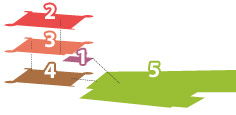
Polyphemus and Galatea (1 of 1)

This work —one of the most important of the Roman Empire— represents a love scene inspired by the Hellenistic poem "The Cyclops". It is a mythological work that served as an inspiration to the Cordoban poet and dramatist Luis de Góngora y Argote to write the fable "Polyphemus and Galatea".
The giant Polyphemus was one of the Cyclops of Sicily, son of Poseidon. Polyphemus is known in the literature for taking revenge for Ulysses’ having blinded him by devouring some of Ulysses’ travelling companions. He loved Galatea and killed his lover — the shepherd Acis— with a rock.
The left-hand side represents the Nymph Galatea. She is naked and adorned with fine jewels; she is wearing a cloak which covers her legs and she is seated on a keto, a wolf-headed sea monster with the body of a snake and the tail of a dolphin. On the right the giant Polyphemus is declaring his love to her. Polyphemus appears naked with a leopard skin covering his legs and brandishing a scepter.
The work is bordered by geometric patterns and it is garland-framed. The background features a realist landscape. Both sides feature rhombuses and four dolphins in the corners.
The work is composed of multicolored tessarea with predominating white, yellow and ochre tones. The vitreous tessarea on the Galatea's cloak and the black ones on the leopard skin covering. Polyphemus are also emphasised. It is interesting to remark the author's special skill in depicting details such as the facial expression had by Galatea.
Press the Play buttons to access a speech version of the description or the audiodescription for visually impaired.
Click in Audiodescription to access to its text version.

Alcazar of the Christian Monarchs. Plaza Campo Santo de los Mártires s/n. 14004 Córdoba
2011 Ayto. de Córdoba. All rights reserved. Legal Advice


